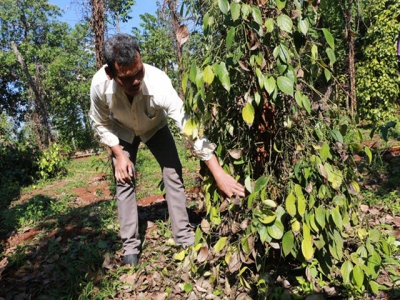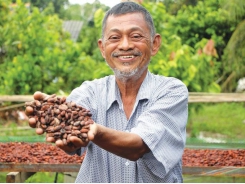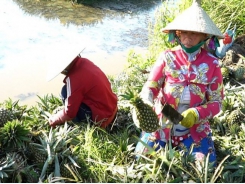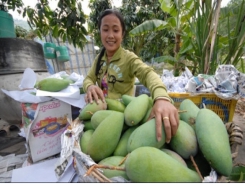Bình Phước enters pepper harvest season, plagued by labour shortage

A farmer checks his pepper farm in Bình Phước Province’s Bù Gia Mập District. – VNA/VNS Photo Dương Chí Tưởng
BÌNH PHƯỚC – Farmers in the south-eastern province of Bình Phước are entering the peak black pepper harvest season but suffer from a shortage of workers.
In Bù Đốp District, the largest pepper growing area in the province, many farmers have to contract workers in advance, increase payment and provide them with lunch.
Đỗ Cao Phong, who owns 4,000 pepper trellises in Bù Đốp’s Thiện Hưng Commune, said he has been looking for workers for harvesting his crop since last month but has only managed to find two.
He needs at least eight workers to harvest his pepper orchard within a month but does not know where to find six more.
Trần Văn Lương, a pepper farm owner in Bù Đốp’s Tân Thành Commune, said to make sure he had enough workers for the harvest, he paid wages of VNĐ180,000 – 200,000 (US$7.8 – 8.6) per day, VNĐ20,000 – 50,000 more than last year.
He too has to provide lunch, he said.
“If pepper is ripe and not harvested, the fruit will fall, reducing the output. Not harvesting ripe pepper will cause the plants to become exhausted and the next crop will be poor.”
This year the harvest season began in January close to Tết (Lunar New Year) meaning many labourers returned home to other provinces and cities before and after the festival, causing a shortage.
Besides, Bình Phước, the country’s largest cashew producer, is also entering the cashew harvest season and so there is an understandable shortage of labourers, according to pepper farmers.
The high wages and declining pepper prices have caused losses for many farmers in the province.
Pepper fetches VNĐ50,000 ($2.1) a kilogramme, down 25 per cent from a year ago.
Bình Phước, which has the third largest pepper growing area in the country, has more than 17,000ha under the spice now, 2,000ha more than the province has zoned for.
Price were high in previous years, inducing farmers to expand cultivation into unzoned areas, according to the province Department of Agriculture and Rural Development.
In Bù Gia Mập District’s Đắk Ơ Commune, a well-known pepper growing area, some 530ha had been affected by diseases as of the end of last month, with 230ha of pepper plants dying.
Nguyễn Thị Lý, who planted 2,000 pepper trellises in Đắk Ơ four years ago, said they began bearing fruit in the second year.
But their leaves turned yellow and they began to die gradually in the fourth year, she said.
She tried many measures to treat the plants but could not save them.
Thân Quốc An Hạ of Institute of Applied Materials Science under the Việt Nam Academy of Science and Technology said soil conditions and poor drainage are major reasons for the death of pepper plants in Đắk Ơ.
The roots are still healthy and not deep between the plants’ first and third years, and so the pepper grows well. But after the third and fourth years, when the roots grow deeper into the soil, if the soil lacks nutrients or is too hard for the roots to penetrate, the plants weaken and die gradually.
Water drainage is poor in many pepper farms and rainwater does not drain properly as a result, causing outbreaks of fatal fungal diseases in the roots.
Lê Thị Ánh Tuyết, deputy director of the province Department of Agriculture and Rural Development, said the province has to review and rezone pepper growing areas.
This would help regulate the area under pepper and manage diseases, yields and food safety and guarantee output, she said.
The province Department of Science and Technology has called on scientists to consider measures to save disease- affected pepper farms.
Pepper is one of the province’s key agricultural products.
Related news
Tools

Phối trộn thức ăn chăn nuôi

Pha dung dịch thủy canh

Định mức cho tôm ăn

Phối trộn phân bón NPK

Xác định tỷ lệ tôm sống

Chuyển đổi đơn vị phân bón

Xác định công suất sục khí

Chuyển đổi đơn vị tôm

Tính diện tích nhà kính

Tính thể tích ao



 Tien Giang rice market faces glut as exports…
Tien Giang rice market faces glut as exports…  US opens doors to Vietnamese mango after 10…
US opens doors to Vietnamese mango after 10…